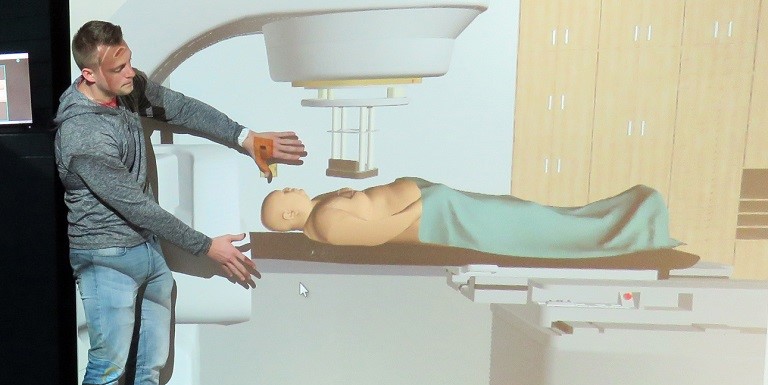Community College of Allegheny County: Radiation Therapy Students Enhance Skills With State-of-the-Art Technology

Students in the Radiation Therapy Technology program at the Community College of Allegheny County (CCAC) are training on equipment just like that used at leading teaching hospitals around the world. In fall 2018, the college acquired a Virtual Environment in Radiotherapy Training (VERT) system that enables students to practice direct hands-on skills in a radiation-free virtual setting without risk to the patient. The virtual simulator replicates the controls of a linear accelerator, which delivers targeted doses of radiation to cancer patients, bringing the level of training typically used in clinical settings into the classroom. CCAC’s Allegheny Campus is one of two institutions in the state—and one of 24 in the country—that houses the technology, the other one being Thomas Jefferson University in Philadelphia, which is the only other institution to offer a Radiation Therapy program in Pennsylvania.
While looking at a three-dimensional image on a screen, students can manipulate the handheld controls of the linear accelerator and send a simulated radiation beam through the body of a virtual patient, observing exactly where the beam goes. The students are also able to look at cross-sectional anatomy and to how critical structures fit together—something they can’t do in the clinic—which helps them learn how to properly identify target areas on CT scans.
Kelli Collette, Associate Professor and Program Director, believes the technology is giving CCAC students an edge because they go into the clinic with more confidence and enhanced technical abilities. Students begin using the advanced technology on the first day of classes.
“The VERT system is significant because when students go to clinic, they’re more prepared, and when they’re more prepared, they’re more confident, and when they’re more confident, their performance is better,” said Collette. “They get real hands-on learning, and they can make a mistake and not be worried that they’re going to harm a patient. We’re so excited to have this system and so thrilled for the support that CCAC has given to us.”
CCAC student Surbhi Sharma, who completed her Associate of Science in Radiation Therapy Technology in July 2019, agrees that the system helps to boost her confidence and performance in the clinic. “For me, the VERT system provides a pressure-free environment in which to learn the skills I need to become a proficient radiation therapy technologist,” said Sharma, who is currently attending Thomas Jefferson University for Medical Dosimetry with the ultimate goal of earning a Ph.D. “It is an engaging virtual system that trains, enhances decision-making skills, and prepares students for real-world applications.”
The system was purchased with funds from a Carl. D. Perkins Career and Technical Education grant. According to Collette, the support of CCAC Allegheny Campus President Dr. Evon Walters was pivotal in obtaining the grant. “Dr. Walters really got the ball rolling,” said Collette. “I give him the credit for recognizing the value of having the VERT system.”
The demand for skilled radiation therapists is growing, particularly with the construction of new medical facilities in the Pittsburgh region. Collette is seeking to add new clinical sites in order to increase the number of students admitted to the program, which is offered in both Associate of Science degree and certificate options.
For more information about CCAC’s Radiation Therapy Technology Program, contact Kelli Collette.
Lead Image: CCAC Radiation Therapy Technology student Tyler Wehrle demonstrates use of the VERT system at Allegheny Campus.
Margaret Anderson is Promotions Writer, Public Relations and Marketing, at Community College of Allegheny County in Pittsburgh, Pennsylvania.
Opinions expressed in Member Spotlight are those of the author(s) and do not necessarily reflect those of the League for Innovation in the Community College.










